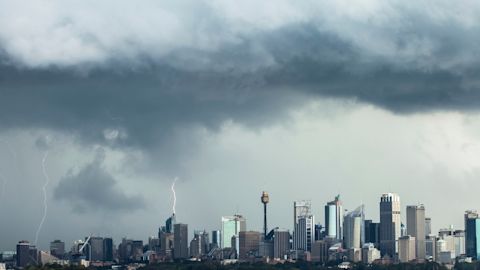We spoke to NSW State Emergency Service City of Sydney unit commander Robert Cooper to find out what steps you can take now to reduce the chance of storm damage in your home.
“There’s not much you can do once a storm hits,” Cooper said. “Our message is to control the things you can control now and know your plan for when a storm arrives.”
Avoid flood waters at all costs
More rain means more chance of flooding. Flash floods are fast moving and extremely dangerous. They can happen at any time, but usually take place a few minutes to a few hours after intense rainfall when creeks, waterways and stormwater drains struggle with the extra influx of water.
You should never drive, walk or ride through flood waters. In fact, if you remember one thing, it’s this:
“If it’s flooded, forget it. Find another way.” - NSW SES unit commander Robert Cooper
You might be tempted to take a chance and drive through shallow flood waters. Think again. In a 2016 test, engineers from the University of NSW found that a small car like a Toyota Yaris, weighing 1.05 tonnes was moved by water only 15cm deep and with a flow speed of as little as 3.6 km/h.
Related: More emergency advice to help you prepare for floods
Take care around trees
Every year the SES responds to about 300 jobs in our local area. Most of these are for trees that have come down in storms.
Take these steps to improve safety around nearby trees:
- Check trees around your home. Overhanging branches may pose a safety risk in a storm. You’ll need a permit to prune or remove trees on your property.
- If there’s a tree in your neighbourhood you think needs pruning or removal, you can report it to us online.
If a storm is on the way:
- avoid parking your car under a tree if you can
- don’t take shelter under trees.
Prepare your home for hail and heavy rain
Hail often accompanies summer storms.
Take these steps to reduce the chance of hail damage in your home:
- Clear your gutters. When hail melts, gutters can get overloaded quickly.
- If you have a skylight, check the seal is in good condition.
- Take a look at the state of your roof tiles. Fix any cracked or broken tiles.
Create a personal emergency plan
If you know what to do, you’re more likely to make the right choices. Create a personal emergency plan for your family and close friends. This should cover what to do, where to meet, where to go and how to communicate in an emergency.
The Red Cross Get Prepared app can help you create, record and put your plan into action.
Related: In case of an emergency: How to be ready if Sydney stops
More information
Find information about preparing your property against storm damage, local risks, planning for emergencies and how to get involved with the SES at ses.nsw.gov.au.
See our emergency advice for storms.
For help in an emergency
For emergency assistance in floods and storms call the NSW State Emergency Service (SES) on 132 500. If the situation is life threatening, immediately call triple zero (000).
Published 26 October 2020, updated 16 October 2025



